May 10th, 2012 § § permalink
The Oak Room in New York’s venerable Plaza Hotel was, in HG’s opinion, the most history-drenched and comfortable restaurant in New York. Alas, HG just learned, the beautiful room has closed. HG has written before about happy times there and merry martini sipping in the adjacent Oak Bar. Memories: Tournedos with Bearnaise Sauce and Souffle Potatoes. Braised Celery with Beef Marrow. Cary Grant (looking and behaving like Cary Grant) at an adjoining table. HG had a charge account at the Oak Room and a tendency to run up large bills. HG, during that cycle in HG’s professional life, did not pay bills promptly. HG relished the good manners and courtesy of the gentle letter he received from the Oak Room management when HG was six months in arrears: “It appears that due to the many pressures and obligations of your career, you may have overlooked etc., etc.,etc.”
HG always paid…Eventually.
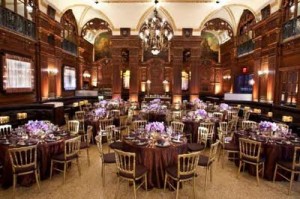
April 29th, 2012 § § permalink
HG rarely waves the flag, believing, to paraphrase Dr. Johnson, that patriotism is the last refuge of fools and knaves. However, when it comes to steak, HG is a red-blooded, Yankee Doodle boy. Nothing compares to American steak (prime,of course). HG never had a good steak in Paris. Much lauded steak frites in a Paris bistro would get thumbs down from discerning New Yorkers (men and women who learned to eat steak on Steak Row and at Peter Luger’s). Alec Lobrano, the most informed and fair minded of Paris food writers, likes the steak at Le Severo in that city. HG and BSK sampled the steak there and found it only passable. However, steak tartare at Severo and at Le Stella and many other Paris eateries is exemplary. German restaurants in New York prepared great steak tartare in years gone by (Luchow’s covered its steak tartare with a generous layer of black beluga caviar). The great raw beef dish disappeared along with New York’s most fabled German restaurants.
If you rent an apartment in Paris, visit the Hugo Desnoyer butcher shop in the 14th and buy a rump steak (Lobrano’s suggestion) and grill it at home. And, if you’re renting a New York apartment, pick up a New York strip at Lobel’s on Madison Avenue. One pound strip: $47.98. (Hey, you only live once).
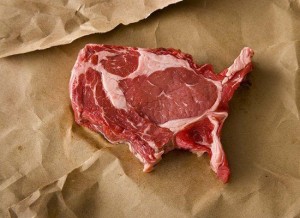
April 23rd, 2012 § § permalink
Just say the word — Nedick’s — and you’ll get a nostalgic sigh from old New Yorkers (or ex-New Yorkers like HG). Nedick’s was a New York fast food chain that served hot dogs on toasted, buttered rolls. HG would top these superior tube steaks with Nedick’s special mustard relish and wash them down with an ice cold orange drink. Two dogs and a drink — 30 cents — a true recession buster. HG’s favorite Nedick’s location was at 161st Street and Jerome Avenue in The Bronx. Very convenient for a bite after a baseball or football game at Yankee Stadium or a sandlot football game at adjacent McCombs Field (HG was a star halfback on the Barnhills, a rough and ready sandlot team).
Nedick’s is part of HG’s unconscious. Nedick’s was the sponsor of New York Knick broadcasts and when a Knick scored, announcer Marty Glickman would intone: “Good — like Nedick’s!!” A few days ago, HG watched New York Knick Carmelo Anthony light up the scoreboard. At a particularly exciting moment, HG found himself shouting at the TV in the voice of Glickman: “Good — like Nedick’s!!” Marty Glickman has passed on. Nedick’s is gone. Efforts to revive the chain have failed. The old Yankee Stadium is gone, replaced by a shiny new model. HG and the Knicks remain. Functional but flawed.
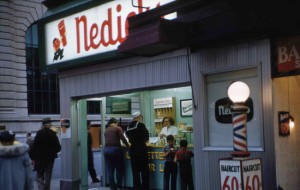
April 17th, 2012 § § permalink
After a basketball game, hockey or boxing match at the old Madison Square Garden (50th Street and 8th Avenue in New York) HG and pals would often go to a long departed German restaurant, Blue Ribbon, located on West 45th. They would devour a huge apple pancake and wash it down with dark beer. The apple pancake was almost 18 inches in diameter and rich with cinnamon, sugar and melted butter. It was thin as a pizza and served on a similar hot, round metal platter. The dish has disappeared. HG hasn’t encountered on a menu for more than 30 years.
The same goes for smoked kippers and eggs, a true breakfast treat that was found in even the most basic New York coffee shop. Gone. Chicken livers seem to have disappeared as well. In New York, the Schrafft’s chain used to serve sauteed livers on buttered toast; French bistros would top salads with them and they were a staple of many pasta sauces in Italian restaurants.
Lamb chops accompanied by grilled kidneys. This was a common pairing (like calf’s liver and bacon). Sure, lamb chops still thrive; but now they’re a solo act – the kidney having been cruelly cast aside.
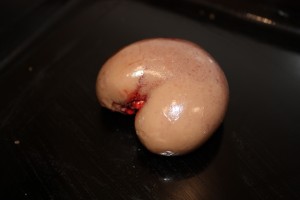
April 2nd, 2012 § § permalink
SJ here. As a dedicated hunter of all sorts of obscure, ethnic food treats, you learn to read the signs — the tells — of a great culinary experience: a line of taxicabs in front of Pakistani take-out, absolute unfamiliarity in English, a certain grittiness mixed with equal parts pride…the list goes on and I was fairly certain my ability to read those signs was infallible. Well, pride is a bitch. What comes up must go down, and so shall I share with you a cautionary tale of When Bad Food Happens To Good Food Hunters:
She had it all. No English. A mouth full of metal. Enthusiasm. A kitchen made up of various coolers and snap lid trays hauled around in a red shopping cart. I had noticed her for a week dishing out food for the Central American workers in the Chinese owned glass and vegetable wholesalers that line Broome Street. I finally decided to make my move and pick up whatever it was she was dishing out. She was thrilled. With what little Spanish I possess I came to understand that she had a chicken stew, with a kind of bean soup and a side of mashed eggplant; and a dish of baccala which did not look appetizing. Sure! I thought. $5 for this awesome meal served out of coolers in between glass cutting machines and a smiling Guatemalan wearing an shirt covered in hand drawn pentagrams and the names of Nordic Black Metal bands — AWESOME! As she dished out the food, I had dreams of writing posts in Chowhound about the brilliance of the meal and how those posts would cause food lovers to wait on line for this incredible street food experience and how one day my hero Robert Sietsema would feast on her chicken and then search me out to thank me for this incredible culinary find and how then we would become best friends and go to Flushing and eat banquets of dumplings together and…..and….and then I tasted my meal.
If it were disgusting, wretched, horrific even — I would have been happier! It would have been an experience I could boast about and say: Remember that time I had that crazy Central American special chicken that tasted of tires and old socks? Unfortunately the Broome Street chicken was just not good in the most boring way. The chicken was very dry and over-cooked. The stew itself had no strong flavors. The eggplant thing tasted of baby food and the bean soupy thing had no zing, no nothing!!!! For all its gritty surroundings and strong, ethnic profile, the meal was as bland as something served up in a hospital. My secret, ethnic food vending lady turned out to be a Midwestern housewife in disguise.
The signs had proved wrong. My arrogance was shattered. My friendship with Robert Sietsema never happened. It will take me some time to recover. Thanks Broome Street Chicken!
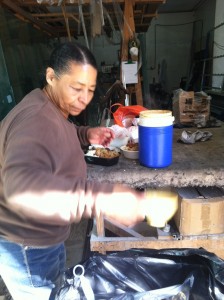
April 1st, 2012 § § permalink
Yes, the great family ritual feast — the Seder — will be celebrated in Jewish and many non-Jewish homes (the Obamas will have a Seder) when Passover comes along this month. Like most great Jewish holidays, Passover and the Seder that goes aong with it exemplifies the theme: “They tried to kill us. They failed. So, let’s eat.”
HG loved the family Seder of his youth. There was gefilte fish (made from scratch by HG’s Mom and served with blazing horse radish hand grated by little HG). Chicken soup with matzo balls (best in the universe). Brisket. Knaidlach (dense matzo meal dumplings that soaked up the lush gravy in the absence of challah or rye bread, forbidden at Passover). Tzimmes (A sweet and tangy carrot stew cooked with honey, ginger and chicken feet. HG was not fond of the chicken feet). Dessert was fruit compote of prunes and apricots plus kosher-for-Passover macaroons. Hot tea served in a glass (HG’s father drank it with a sugar cube clutched in his teeth). Schapiro’s sweet malaga wine was served during the meal along with Horowitz-Margareten matzos (the brand favored by HG’s discerning Mom). Though a life-long Socialist who was skeptical of religion, Hershele Zvi Freimann (HG’s Dad), donned a prayer shawl and yamelkeh (skull cap) for the reading of the Haggadah (Passover prayer book).
The HG family Seder was not a sober affair. There was the aforementioned sweet wine. Little HG was allowed to drink as much of this wine as HG wanted and — foretelling the future — HG wanted a lot! There was also vishniak, a sweet, very potent cherry brandy home brewed by Hershele Tsvi Freimann. HG was allowed only a tiny sip of this fire brew. Best of all, there were the sweet, wrinkled cherries that had been long marinated in the vishniak. HG managed to snare a few of these super-alcoholic goodies which made the little chap a happy and drowsy fellow.
There was a somber note in these festivities. The “blood libel” was very much alive in the Belorussia of HG’s parents youth. The “blood libel” was the claim that Jews killed a Gentile child at Passover because the child’s blood was an essential ingredient in making matzos. This is a claim still being made by some Jihadists, neo-nazis and other rabid Jew haters. HG’s parents both recalled the murderous “blood libel” pogroms in Kishinev, a city in Bessarabia (then part of Rumania). Hundreds of Jews were killed. These dark thoughts were banished from the Seder table by vishniak and the hope that HG, his sister and brother would never experience such horrors.
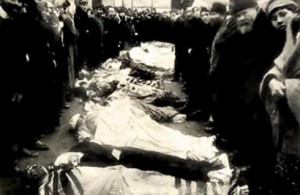
Victims of the Kishinev Pogrom
March 16th, 2012 § § permalink
In days of yore when New York was almost solely an Irish-Italian-Jewish influenced city, the Irish were (in HG’s opinion) very unfairly maligned as food-know-nothings — folks who paid undue attention to strong drink and not enough to good eating. Well, HG (in his impecunious college and early journalist days) ate very well in Manhattan’s Irish saloons. These joints either bore the name of the proprietor (Kelly, Murphy, etc.) or their ancestral turf (Kerry, Down, Shannon,etc.). For some reason (probably low rent) they were often located under the elevated trains that used to roar around the city (Third Avenue, Sixth Avenue, Pearl Street,etc. — all of which were demolished just before or a few years after World War Two). As noted previously by HG, most saloons had big jars of pickled pig knuckles and hardboiled eggs on the bar. But, the big specialty — you guessed it — was corned beef and cabbage. HG can visualize it now: A big, indestructible plate with three healthy slices of corned beef rimmed in fat (fat is flavor, of course); a wedge of cabbage (alas, often overcooked); large boiled potato; hot mustard. A glass of Ballantine’s beer straight from the tap kept it company. This was straightforward, hearty food much appreciated by the working class clientele of the saloons. Customers were classier (stockbrokers, tea, coffee and cocoa brokers) In the saloons under the Pearl Street El. And, the corned beef and cabbage was a shade more aristocratic. Some gin mills had steam tables where inedible beef and lamb stew languished.
A true gourmand destination was a Third Avenue saloon named Connolly’s (near 23rd Street, HG recalls) that was a favorite of uniformed cops as well as detectives and other law enforcement types. The parade dish was pot roast and it was the best HG has ever tasted. It was served as a knife-and-fork sandwich. The very thick sandwich was placed in a bowl and lavishly doused with extraordinarily lush and robust dark brown gravy. Ah!! Up the Rebels!!
Erin Go Bragh!!

March 14th, 2012 § § permalink
Jaime “Jimmy” Rodriguez, Jr. made Puerto Rican food hip, and for a while, made West Fordham Road in The Bronx a dining destination for everyone from President Clinton to Derek Jeter to Fidel Castro. Jimmy’s Bronx Cafe opened in 1993 on the site of a former auto dealership, a short cab ride from Yankee Stadium. It was a smash. Derek Jeter had his birthday party at Jimmy’s and it was a hangout for Yankees and visiting teams. Jimmy hosted a dinner there for Fidel Castro in 1995 (there were 500 in attendance and Jimmy got a lot of criticism from Cuban emigres). Jimmy’s was vast. The food (specially the seafood) was wonderful. Great music (Tito Puente headed one of the bands). Fiery dancing. Everybody cool in the worlds of sports, show biz and politics visited Jimmy’s and Jimmy Rodriguez was honored by New York’s top business and civic organizations.
Jimmy expanded with a branch in Harlem, one on E. 57th Street in Manhattan and a sea food place on City Island in The Bronx. At their height, the Rodriguez restaurants were grossing $10,000,000 a year. The woes of over-expansion soon kicked in however and by 2004 they were all gone.
Bronx born Rodriguez (1963) got his start by joining his father selling seafood from the trunk of their car parked near an entrance to the Major Deegan Expressway. They made a chowder from the leftover seafood, added some Puerto Rican dishes and opened a stand on a Fordham Road corner which was followed by a 50-seat storefront joint, Marisco del Caribe. That operated for about 10 years before the ambitious young man opened Jimmy’s Bronx Cafe.
Well, Jimmy is back. There are four Jimmy’s restaurants now operating in the New York area (or are they?…given Jimmy’s volatility, be wise and call first). The restaurants are the two Don Coqui locations in Astoria and New Rochelle (both run by Jimmy’s daughters, Jaleene and Jewelle); the two Sofritos on E. 57th in Manhattan and in White Plains and Sazon on Reade Street in downtown Manhattan. Creole cooking and Jimmy Rodriguez — Olé!

Jimmy Rodriguez at Sofrito
March 13th, 2012 § § permalink
Rosenhain’s. Fanciest restaurant in The Bronx. Flourished in the 30’s-40’s. Charles Lindbergh met there with both the owner (Max Rosenhain) and ransom intermediaries during his son’s kidnapping.
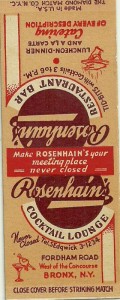
Lido-Riviera. Fordham University football team celebrated there after they beat Missouri in the 1942 Sugar Bowl.

Jackson’s Steak House. The late Gil Scott-Heron — the great poet, jazz musician and inconic influence on the entire genre of music known as hip hop — worked there when he was a Bronx teenager.
Bordewick’s. Food and dancing. Hillman’s. Hearty, German-influenced food.
Jimmy’s Bronx Cafe — A relative latecomer to the game made Fordham Road sparkle for a number of years with great Puerto Rican Carribean-Creole Food.
All gone. All flourished on Fordham Road, the lively Bronx thoroughfare that runs east-west between Major Deegan Expressway and Bronx Park. Lots to see on Fordham Road. The Fordham campus on Rose Hill. The super-busy shopping district. The 11-building Fordham Hill co-op high-rise apartment complex overlooking the Harlem River. It’s known as “The Oasis In The Bronx.”
Yes, there are plenty of great restaurants left in the Bronx and even close by Fordham Road itself, but great food on the Road? All vanished. All gone.
March 4th, 2012 § § permalink
Fast food franchise junk, escalating real estate prices, changing customs. These all knocked out the great New York cafeterias that fed old schmoozers, loquacious intellectuals, cab drivers, garment center workers, students, artists — everybody, in fact. In terms of cuisine, the best was Dubrow’s. There were three: one in the garment center (this was where HG dined before Knicks games at Madison Square Garden); one on Eastern Parkway in Brooklyn (where HG dined after watching Joe Klein, Floyd Paterson, Joey Giardello and other fighters at the Eastern Parkway Arena); another branch on Brooklyn’s Kings Highway (too quiet and staid for HG). All were decorated in high, post-Depression, “modernist” style with plenty of mirrored walls and pale, glistening wood. The garment center Dubrow’s (on Seventh Avenue in the 30’s) was a madhouse during weekday lunch hours. The wonder was how the cloak-and-suiters and skilled workers could eat so much and talk so much at the same time. The Eastern Parkway Dubrow’s was favored by Jewish bookmakers, horse players, gamblers, loan sharks and the last remnants of Brownsville’s Murder Inc. and associated Lepke mob. These were guys who favored expensive hats, sharp suits (by Brooklyn’s Abe Stark) and big cigars. A guy not wearing a suit, tie and hat was a “bum,” despised by all. By 1985 all the Dubrow’s were gone.
The Belmore Cafeteria on 28th Street and Park Avenue South (Fourth Avenue before the fancy name change) was a 24-hour-a-day place favored by cab drivers. Martin Scorcese’s movie “Taxi Driver” burnished its fame. The scenes between Robert DeNiro and Peter Boyle take place in front of The Belmore. Phil Siegel ran The Belmore for decades and never changed its motto: “New York’s Most Fabulous Restaurant.” Like Dubrow’s, it had plenty of Jewish and Eastern European specialties but there were many eclectic culinary surprises as well. It was always busy. At its peak, The Belmore fed some 5.000 New Yorkers every weekday. Siegel sold the cafeteria and its corner site in 1981 to developers of a “sliver” condo development.
A sad and quiet cafeteria was The Senate on Broadway and 96th. There were lots of tattoos there. No, not the multi-colored skin-scapes favored by today’s hipsters. These were the grim number tattoos of Holocaust survivors, men and women who conversed quietly over endless cups of tea. I.B. Singer, the Nobel Prize-winning Yiddish writer, was often there eating tuna salad (he also favored The Eclair,a middle European pastry shop and restaurant on W.72nd). Singer based many of his stories on the aged folks he met there — people whose stories bordered on the supernatural. There were two other groups at The Senate: junkies and hookers. The strung out junkies ate trays of the sweetest cakes they could find The hard working hookers favored more robust fare. They ate fast. Their demanding business agents didn’t like them taking too much time off.
The cafeterias of New York have vanished. Mickey Dee and the landlords have won.
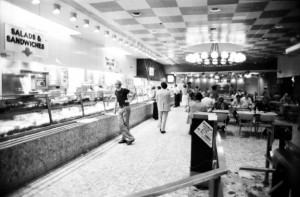
The Belmore circa 1976










